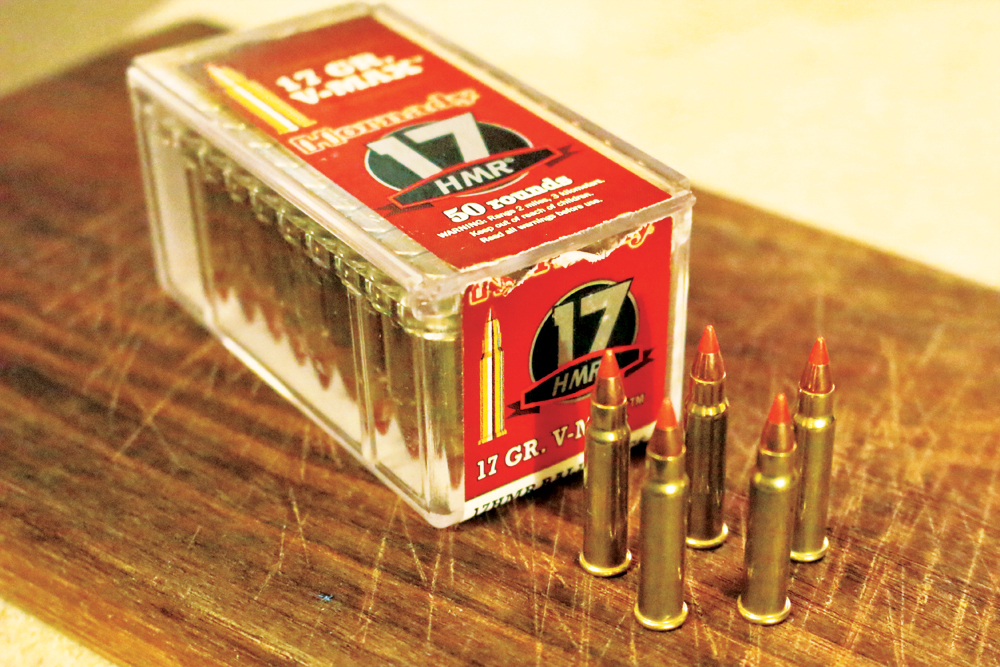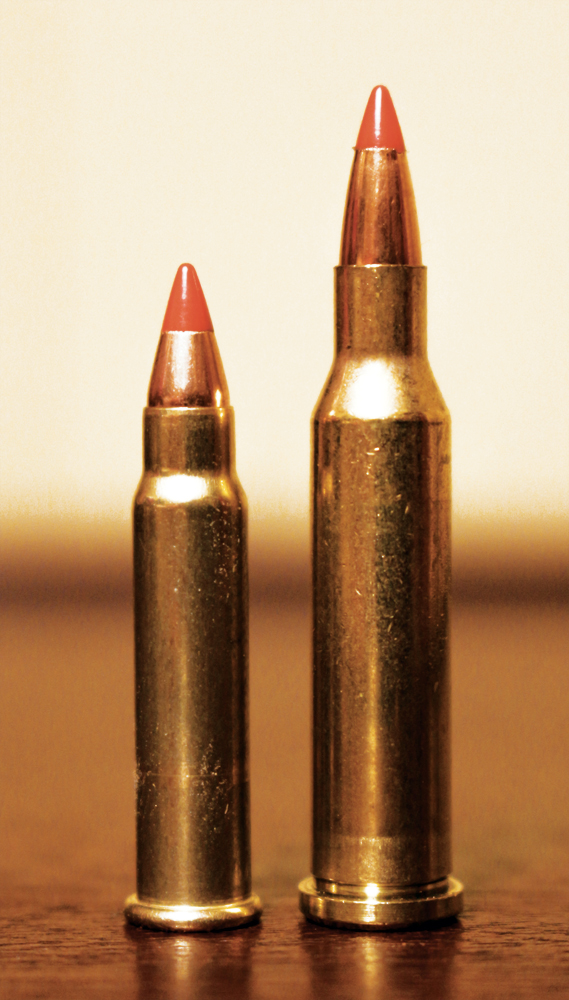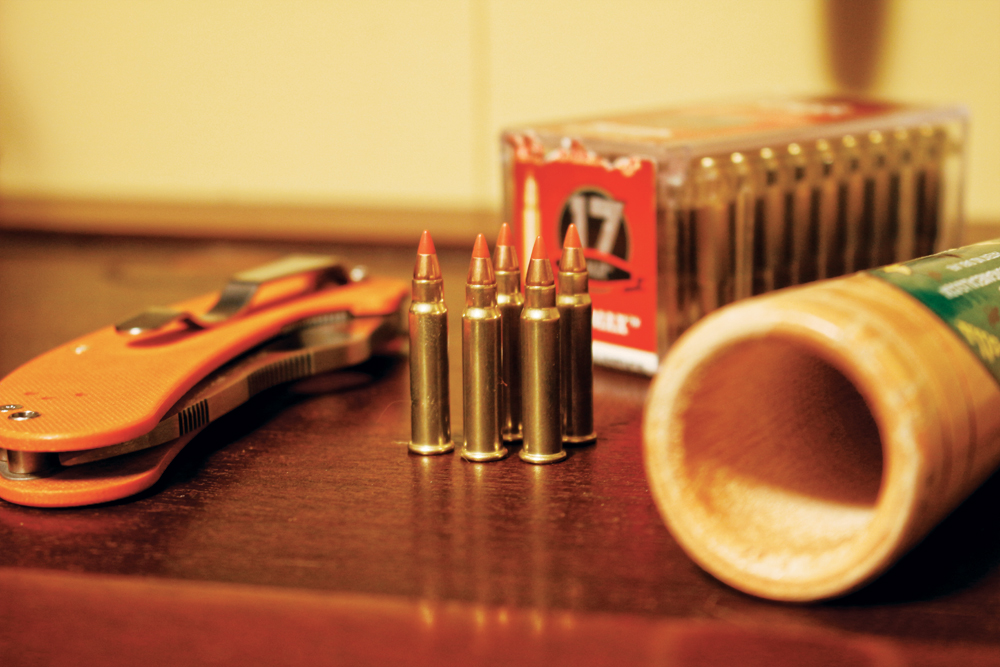
 With lighter, faster projectiles, .17-caliber rimfires such as the .17 WSM and .17 HMR offer some advantages over more established rimfires like the .22 Long Rifle.
With lighter, faster projectiles, .17-caliber rimfires such as the .17 WSM and .17 HMR offer some advantages over more established rimfires like the .22 Long Rifle.
Undoubtedly, the majority of our hunting careers were sparked by an experience with the .22 Long Rifle cartridge; it has become a ubiquitous icon in the youth of any shooting upbringing. The simple rimfire design, coupled with a complete lack of recoil, has been used to teach generations of marksmen how to properly hit a bullseye and to put meat on the table, no matter how small the portions might have been.
However, just as the .22 LR was an evolution of the .22 Short and .22 Long that preceded the legendary design, the .22 Winchester Rimfire Magnum became an upgrade of the .22 LR, giving greater velocities and more striking energy. In 2002, ballisticians at Hornady decided it was high time to shake things up and neck the .22 Magnum down to .17 caliber; the .17 Hornady Magnum Rimfire (HMR) arrived with much fanfare. It would utilize a 17-grain spitzer bullet, driven to 2,550 feet per second (fps) for a flat trajectory, flatter than any rimfire that had come before.

The new, hyper-velocity cartridge was an instant success, and even though the tiny bullet was extremely sensitive to wind drift, many hunters flocked to the gun shops for a new cartridge to play with. The .17 HMR is a very accurate cartridge, fully capable of taking headshots on squirrels and other small targets, as well as extending the effective range of the rimfire rifle on distant woodchucks, coyotes and foxes. It was followed, two years later, by the .17 Hornady Mach II, based on the CCI Stinger variant of the .22 LR cartridge.
Fast-forward a decade and you’d see the great firm of Winchester as busy as a beehive, hard at work releasing the .17 Winchester Super Magnum (WSM). Having seen the success of Hornady cartridges, Winchester created a cartridge based on, of all things, the .27-caliber nail gun blank — used for driving nails in concrete and other hard surfaces. For three years, the wizards at Winchester secretly toiled away in their towers — with some help from the sages at Savage — crafting a rimfire cartridge that would achieve unprecedented velocities, and upon release to the shooting public, lived up to its goals. The .17 WSM drives a 20-grain bullet to an even 3,000 fps and a 26-grain bullet to 2,600 fps.

How do the two compare and contrast? And for what hunting/shooting situations are they best suited? Well, let’s get this statement out of the way: They aren’t as economical or available as the good ol’ .22 LR, and while both of the cartridges have a velocity and trajectory advantage over the reigning rimfire cartridge, it’s going to be very difficult to become a threat to the crown.
Being rimfire, and therefore virtually un-reloadable, the cartridges are a one-and-done proposition. But, for the hunter who wants a rifle that can reach out for the occasional 150-yard shot, without the report of the smaller centerfires — like the .17 Hornet and .17 Remington — the .17-caliber rimfires have an appeal. While the .17 Hornet — one of the slower centerfires of this caliber — bests the velocity of the .17 WSM by 650 fps, the rimfire .17s fill a needed void.
Those tiny .172-inch diameter pills will certainly get the job done on the smaller game animals such as squirrels and rabbits, as well as the furbearing mammals like foxes, bobcats and even coyotes, at closer ranges. For the fur hunter, these little bullets with their high velocity and light sectional density figures will help minimize pelt damage.
They both make a bit of noise; being supersonic, they probably aren’t the best choice for shooting garden pests while trying to go unnoticed. But in a situation where you don’t want a high velocity bullet sailing out of control, the .17 HMR and .17 WSM provide a relatively flat trajectory, yet with a highly frangible bullet that significantly reduces the risk of an errant bullet causing harm.
Let’s take a look at the differences between the .17 HMR and the .17 WSM in some real-world situations. Hornady makes ammunition for both cartridges, so to keep things even, I’ll use their stuff for the basis of the comparison.
Both of these cartridges are fully capable of maintaining a 100-yard zero, without the mid-range trajectory becoming ridiculous. Using a 20-grain bullet loaded in both cartridges you’ll find the .17 WSM with a V-Max bullet hits 4.10 inches low at 200 yards, while the .17 HMR loaded with a 20-grain XTP hollowpoint hits just under 10 inches low at the same distance. Now, while the WSM needs just a touch of holdover at two-hundy, the HMR needs some careful attention out past 125 yards. Not that the shot is impossible, but the holdover becomes crucial, especially on the smaller targets.

Wind can be an absolute nemesis to any .17-caliber cartridge, be it centerfire or rimfire. The bullets simply lack the weight to defy the effects of crosswind, and learning how to dope the wind with any of these rifles will test the mettle of any rifleman. That being said, it’s a matter of simple physics to explain that all bullets of equal shape and weight will drop at the same rate.
With that in mind, the faster a bullet travels, the more ground it will cover before that drop occurs, hence the trajectory advantage of the WSM cartridge. If you are looking for a rimfire cartridge that has the capability to reach-out-and-touch-someone, I feel that the .17 WSM has the advantage. If you like a cartridge with more choices in the bullet weight department, perhaps the .17 HMR is your baby. Hornady loads the 15.5-grain NTX, 17-grain V-Max and the 20-grain hollowpoint XTP.
In either case, the faster .17 rimfires will provide a definitive advantage over the .22 LR, and in certain circumstances even over the .22 Mag. Even though the .17s are a specialty case, requiring their own special cleaning rods and patches, they are a ton of fun to shoot and very effective in the field.
Expand Your Knowledge on .17 HMR
- Breaking Down .17 HMR vs .22 Mag Accuracy for Target Shooting
- A Guide to Choosing the Best .17 HMR Ammo
- Top Picks for the Most Accurate .17 HMR Rifle
- A Look at the Best .17 HMR Pistols Available Today
Editor's Note: This article is an excerpt from the Spring 2016 issue of Gun Digest the Magazine.

Next Step: Get your FREE Printable Target Pack
Enhance your shooting precision with our 62 MOA Targets, perfect for rifles and handguns. Crafted in collaboration with Storm Tactical for accuracy and versatility.
Subscribe to the Gun Digest email newsletter and get your downloadable target pack sent straight to your inbox. Stay updated with the latest firearms info in the industry.

![Best Concealed Carry Guns In 2025 [Field Tested] Wilson Combat EDC X9S 1](https://gundigest.com/wp-content/uploads/Wilson-Combat-EDC-X9S-1-324x160.jpg)


![Best 9mm Carbine: Affordable PCCs [Tested] Ruger Carbine Shooting](https://gundigest.com/wp-content/uploads/Ruger-Carbine-Shooting-100x70.jpg)
![Best AR-15: Top Options Available Today [Field Tested] Harrington and Richardson PSA XM177E2 feature](https://gundigest.com/wp-content/uploads/Harrington-and-Richardson-PSA-XM177E2-feature-100x70.jpg)

Very Good Article, I hax a A Savage 17 HMR
That was Very Accurate and did the job
On Small Game. I first shot A BMag
at A Prarie Dog Hunt in Navada and
Could Reach out Farther and With
More Down Ranve Energy. I got a Stainless
Bull Barrel with a After Market Stock!